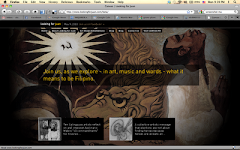Sunday, August 21, 2011
RIZALPABETO
RIZALPABETO is a collaboration between artist Elmer Borlongan and poet Vim Nadera. In this pioneering exhibit, Emong uses the iPad as his medium to bring Vim's poems celebrating the life and legacy of Philippine National Hero Jose Rizal to life.
Curated by J. Pacena, CANVAS will showcase a "teaser" exhibition of Rizalpabeto at ManilArt 2011 from August 24-27, 2011 at the NBC Tent, Bonifacio Global City.
Rizalpabeto will be launched as a children's book, and as signed limited edition giclee prints (edition size: 5) in October. If interested in reserving prints, please email info@canvas.ph.
Friday, August 12, 2011
KULO IN BLACK AND WHITE

Conrado de Quiros wrote, the issue is "complicated." We don’t agree. We think it’s possible to frame most of the issues in black and white terms that are answerable by yes or no.
1. The artwork was offensive. There is no debate there. Deliberate or not, it was not only incendiary, but foreseeably incendiary.
2. Mideo Cruz had every right to make his artwork. That it offends did not diminish his right.
3. The freedom of religious exercise is irrelevant here. No one is preventing anyone from exercising his or her religion.
4. That the artwork was offensive or disgusting does not make it any less an artwork. When do you call something art? Answer: when the person who made it says it is. The gray area is whether it is good art or bad art. If Mideo says it’s art, then it is. Everyone else is free to decide whether they like it (It’s good!) or not (It's bad!).
5. Horrendous art does not justify horrendous deeds. When the Inquirer says that the violence inflicted on the exhibit is “understandable”, we only hope they mean they could understand why someone would be driven to such extreme measures. But violence against art and artists (or anyone else with something to say, for that matter) is never justified. Not even in the defense of one’s faith.
6. Was the CCP wrong to host the exhibit? There is no black and white answer for this one.
If it were a private venue, then the answer would be clear - No, it was not wrong. It is free to host any art exhibition that it wants (subject of course to existing laws to protect minors - but in such cases, the appropriate response would be to regulate the attendance but not to ban the show).
But this is a public institution, utilizing public funds. So the question is quite murky. On the one hand, the CCP is charged with fostering the development of art in the country, which would inevitably involve hosting art on the edge such as Kulo (it is important to note that Mideo’s piece was just one among many). On the other hand, as a public institution, it cannot and should not ignore the sensitivities of the public.
The CCP needs to balance these sometimes competing concerns, and if there is anything to be learned from this unfortunate incident, it is that the CCP must have a clear and transparent policy on what it can or cannot host within its halls. Only with such a policy in place can artists know how far they can go when they exhibit their works at the CCP, and in this manner, the CCP also insulates itself from charges of censorship (because the artists would remain free to exhibit their works elsewhere).
Only with clarity can we avoid similar problems as this one.
7. Was the CCP wrong to close the exhibit? Yes, it was.
There is a difference between refusing to host an exhibit because of public policy considerations from the onset versus closing down an exhibit because of a public outcry over its content.
The former is a valid exercise of prudence and mandate. The latter is a capitulation to a mob. The CCP should have stood its ground and fulfilled its duty, and the closure was therefore a shameful defeat for the right of free expression.
To view exactly what was closed down, please click here.
Monday, August 8, 2011
A Teaching Moment on Free Expression
1. Why is burning an effigy of our president not considered offensive or criminal? Is it not meant to provoke and attack? Is it not an act of gross disrespect for an important figure of authority? Should such acts now therefore be banned?

2. If that doesn't cross the line, what about burning the president in effigy AND burning a truly important cultural and patriotic symbol like the flag?
We do have a law prohibits acts "[t]o mutilate, deface, defile, trample on or cast contempt or commit any act or omission casting dishonor or ridicule upon the flag or over its surface." We went to google to see if we could find any examples or pictures of someone burning the Philippine flag and - to our surprise and pride - came up empty. But this one's close enough:
 In the US, flag burning is recognized as a legitimate expression of protest. As far as we know, the law banning the mutilation and defacement of the Philippine flag has not been tested in court against the Constitutional right of free speech.
In the US, flag burning is recognized as a legitimate expression of protest. As far as we know, the law banning the mutilation and defacement of the Philippine flag has not been tested in court against the Constitutional right of free speech.
In such a test, on which side would you stand?
3. In an opinion piece, the Philippine Daily Inquirer wrote that
(t)he danger here is that his art could become arrogant and terror-prone. The Church has experienced a tumultuous history of iconoclastic revolutions across the centuries (the Byzantine iconoclastic outbursts in the first millennium and the Protestant revolts in the second) that have destroyed priceless items in man’s cultural heritage.
The question is, so what?
Isn't art and music and words sometimes legitimately arrogant and terror-prone? Isn't arrogant and terror-prone art still free speech?

Where would our country be if Rizal had written Noli, or if our legislators had succumbed to similar Church-led pressure against the Rizal bill?
4. Who's to say what's art or what's not art?
Is this painting art? Is it merely disdainful, or did it cross some line that makes it scandalously disrespectful and blasphemous?
(Disclosure: From where we sit, we like it. We liked it enough to acquire for our permanent collection. )
5. Finally, given the chilling effect that has been imposed with blunt force on the Cultural Center of the Philippines and on the participating artists, who in the creative sector now will dare use their work to question the powers that be?
Regardless of where you stand on this particular exhibit, is it really worth it to set this precedent?





